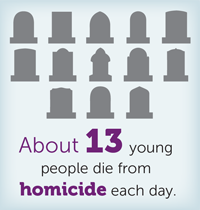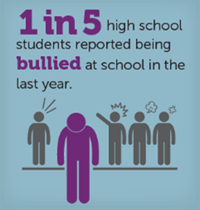Help Young People Grow Up Violence-Free

All young people deserve to grow up safely and thrive. Learn more about how you can help prevent youth violence and #StopBullying in your community!
What Is Youth Violence?
Youth Violence is the intentional use of physical force or power to threaten or harm others by young people ages 10-24. Examples include bullying, fighting, threats with weapons, and gang-related violence. Youth violence is an adverse childhood experience (ACE). It is linked to other forms of violence including teen dating violence, suicide, and adult intimate partner violence.
National Youth Violence Prevention Week is March 30th – April 3rd!
Did you know?

Youth Violence
- Youth violence affects thousands of young people each day.
- Homicide is the third leading cause of death for young people ages 10-14.
- Youth violence resulted in more than 400,000 non-fatal injuries in 2018.
- Youth violence affects entire communities by increasing health care costs; decreasing property values; and negatively impacting perceived and actual safety, participation in community events, school attendance, and the success of businesses.

Bullying
- Bullying is a type of youth violence.
- Bullying can happen in person and through technology (sometimes known as cyberbullying or electronic bullying).
- Bullying negatively impacts all youth involved—those who are bullied, those who bully others, and those who witness the bullying (bystanders).
Prevention is possible. Learn how you can help!
Community members, youth, and adults who care for youth have important roles in preventing violence, and their actions can contribute to the development of safe and supportive communities where young people can reach their full potential. We all have a role to play in preventing youth violence.
Promote family environments that support healthy development
- Everyone can support programs that help families create and maintain safe and nurturing relationships and environments.
- For example, early childhood home visitation programs, like the Nurse Family Partnership® (NFP) program, and parenting skill and family relationship programs like The Incredible Years®.
Provide quality education early in life
- Everyone can support preschool enrichment with family engagement programs that provide high-quality early education and support to economically disadvantaged families to build a strong foundation for future learning and healthy development.
- Examples include Child Parent Centers (CPCs) and Early Head Start (EHS)
Strengthen youth’s skills
- Schools can participate in universal school-based violence prevention programs that often include guidance for teachers on ways to build youth’s skills, monitor and manage behavior, and build a positive school environment.
- Examples include Good Behavior Game (GBG), Promoting Alternative Thinking Strategies® (PATHS), Life Skills® Training (LST), and Steps to Respect (STR).
Connect youth to caring adults and activities
- Schools and other youth serving organizations can offer after-school programs that provide opportunities for youth to strengthen their social and academic skills and become involved in school and community activities.
- For example, the After School Matters (ASM) program offers students opportunities to practice leadership, decision-making, and problem-solving skills.
- As a member of the community, you can volunteer for mentoring programs like Big Brothers Big Sisters of America (BBBS) or volunteer as a tutor to create a relationship that will positively influence a young person’s growth, skills, and academic success.
Create protective community environments
- As a community member, you can help change the physical and social environment by improving the physical characteristics of certain areas where people gather.
- Examples include cleaning up sidewalks and other public spaces like vacant lots and sponsoring community events that bring people together.
- As a community member you can also support street outreach programs like Safe Streets that work to change community norms about the acceptability of violence
Intervene to lessen harms and prevent future risk
- Know where and how to get help.
- Treatments like Trauma-Focused Cognitive Behavioral Therapy® (TF-CBT) can help reduce symptoms of PTSD, depression, and behavioral problems, as well as strengthen positive parenting practices.
- Functional Family Therapy (FFT), Multidimensional Treatment Foster Care (MTFC), and Multisystemic Therapy® (MST) treatments are available for young people with histories of violence that can help prevent problem behavior in the future.
- Hospital community partnership programs like SafERteens support youth after recieving care in emergency departments by using motivational interviewing and connecting them with case-management services.
We all have a role to play in preventing bullying.
Know the signs for bullying:
Not all children who are bullied show warning signs, but StopBullying.gov suggests being aware of these common signs:
Not all children who are bullied show warning signs, but StopBullying.gov suggests being aware of these common signs:
- Unexplained injuries
- Lost or destroyed clothing, books, electronics, or jewelry
- Frequent headaches or stomachaches, feeling sick or faking illness
- Difficulty sleeping or frequent nightmares
- Declining grades, loss of interest in schoolwork, or not wanting to go to school
Know your role in bullying prevention:Parents, school staff, and other caring adults can play a role in bullying prevention:
- Help kids understand bullying.Talk about what bullying is and how to stand up to it safely. Tell kids bullying is unacceptable. Make sure kids know how to get help.
- Keep the lines of communication open.Check in with kids often. Listen to them. Know their friends, ask about school, and understand their concerns.
- Encourage kids to do what they love.Special activities, interests, and hobbies can boost confidence, help kids make friends, and protect them from bullying.
- Model how to treat others.Serve as role models by treating everyone with kindness and respect.
Resources
CDC’s Youth Violence Prevention Resources
CDC’s webpage that contains youth violence prevention resources, including resources for bullying prevention.
CDC’s webpage that contains youth violence prevention resources, including resources for bullying prevention.
StopBullying.gov
StopBullying.gov provides information on bullying, cyberbullying, who is at risk, and how you can prevent and respond to bullying.
StopBullying.gov provides information on bullying, cyberbullying, who is at risk, and how you can prevent and respond to bullying.
Espanol.StopBullying.gov– Spanish website
Division of Adolescent and School Health (DASH)
CDC’s DASH works to promote environments where youth can gain health knowledge and skills, establish healthy behaviors, and connect to health services.
CDC’s DASH works to promote environments where youth can gain health knowledge and skills, establish healthy behaviors, and connect to health services.
No hay comentarios:
Publicar un comentario